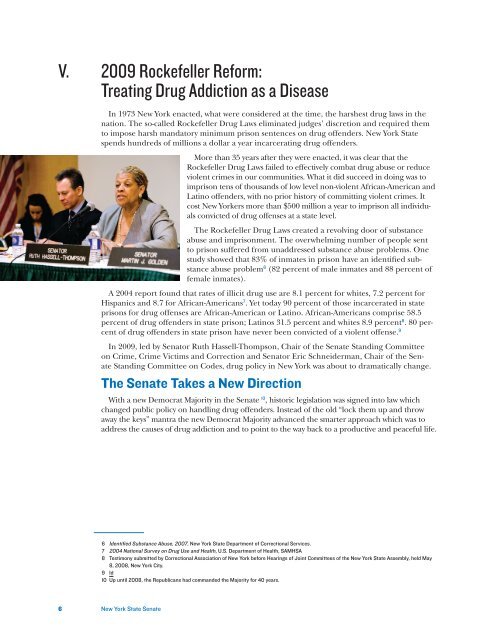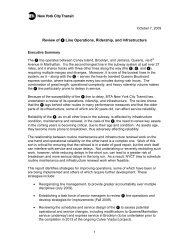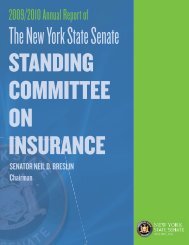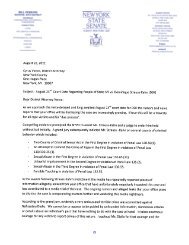Crime Committee Report e.indd - New York State Senate
Crime Committee Report e.indd - New York State Senate
Crime Committee Report e.indd - New York State Senate
You also want an ePaper? Increase the reach of your titles
YUMPU automatically turns print PDFs into web optimized ePapers that Google loves.
V. 2009 Rockefeller Reform:<br />
Treating Drug Addiction as a Disease<br />
In 1973 <strong>New</strong> <strong>York</strong> enacted, what were considered at the time, the harshest drug laws in the<br />
nation. The so-called Rockefeller Drug Laws eliminated judges’ discretion and required them<br />
to impose harsh mandatory minimum prison sentences on drug offenders. <strong>New</strong> <strong>York</strong> <strong>State</strong><br />
spends hundreds of millions a dollar a year incarcerating drug offenders.<br />
More than 35 years after they were enacted, it was clear that the<br />
Rockefeller Drug Laws failed to effectively combat drug abuse or reduce<br />
violent crimes in our communities. What it did succeed in doing was to<br />
imprison tens of thousands of low level non-violent African-American and<br />
Latino offenders, with no prior history of committing violent crimes. It<br />
cost <strong>New</strong> <strong>York</strong>ers more than $500 million a year to imprison all individuals<br />
convicted of drug offenses at a state level.<br />
The Rockefeller Drug Laws created a revolving door of substance<br />
abuse and imprisonment. The overwhelming number of people sent<br />
to prison suffered from unaddressed substance abuse problems. One<br />
study showed that 83% of inmates in prison have an identified substance<br />
abuse problem 6 (82 percent of male inmates and 88 percent of<br />
female inmates).<br />
A 2004 report found that rates of illicit drug use are 8.1 percent for whites, 7.2 percent for<br />
Hispanics and 8.7 for African-Americans 7 . Yet today 90 percent of those incarcerated in state<br />
prisons for drug offenses are African-American or Latino. African-Americans comprise 58.5<br />
percent of drug offenders in state prison; Latinos 31.5 percent and whites 8.9 percent 8 . 80 percent<br />
of drug offenders in state prison have never been convicted of a violent offense. 9<br />
In 2009, led by Senator Ruth Hassell-Thompson, Chair of the <strong>Senate</strong> Standing <strong>Committee</strong><br />
on <strong>Crime</strong>, <strong>Crime</strong> Victims and Correction and Senator Eric Schneiderman, Chair of the <strong>Senate</strong><br />
Standing <strong>Committee</strong> on Codes, drug policy in <strong>New</strong> <strong>York</strong> was about to dramatically change.<br />
The <strong>Senate</strong> Takes a <strong>New</strong> Direction<br />
With a new Democrat Majority in the <strong>Senate</strong> 10 , historic legislation was signed into law which<br />
changed public policy on handling drug offenders. Instead of the old “lock them up and throw<br />
away the keys” mantra the new Democrat Majority advanced the smarter approach which was to<br />
address the causes of drug addiction and to point to the way back to a productive and peaceful life.<br />
6 Identified Substance Abuse, 2007, <strong>New</strong> <strong>York</strong> <strong>State</strong> Department of Correctional Services.<br />
7 2004 National Survey on Drug Use and Health, U.S. Department of Health, SAMHSA<br />
8 Testimony submitted by Correctional Association of <strong>New</strong> <strong>York</strong> before Hearings of Joint <strong>Committee</strong>s of the <strong>New</strong> <strong>York</strong> <strong>State</strong> Assembly, held May<br />
8, 2008, <strong>New</strong> <strong>York</strong> City.<br />
9 Id<br />
10 Up until 2008, the Republicans had commanded the Majority for 40 years.<br />
6<br />
<strong>New</strong> <strong>York</strong> <strong>State</strong> <strong>Senate</strong>









![[PDF] Proposed MTA Capital Program - New York State Senate](https://img.yumpu.com/24854139/1/190x245/pdf-proposed-mta-capital-program-new-york-state-senate.jpg?quality=85)






